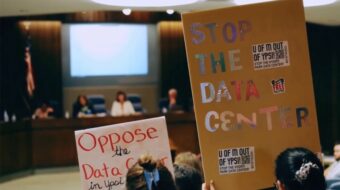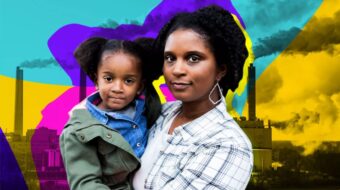Original source:
On May 21st, following months of work, the House Energy and Commerce Committee passed the American Clean Energy and Security Act of 2009 (ACESA), a 932-page piece of climate legislation. There have been mixed reactions from environmental and climate groups, but most groups are in agreement that it needs to be strengthened going forward. For some groups the problems they see with the bill have led to their public withdrawal of support. These groups include Greenpeace USA, Public Citizen and Friends of the Earth. The Chesapeake Climate Action Network also does not support the bill in current form.
Below is a summary analysis of the main features of the bill.
* Cap and Trade System: The bill would establish a ‘cap-and-trade’ system which sets mandatory and declining limits on greenhouse gas emissions over the next 40 years. By 2050 it projects reductions of 83% from 2005 levels for the United States. It does this primarily through the establishment of 1) a ‘cap’ on emissions and the annual issuance by the government of permits to emit greenhouse gases, both of which — the cap and the emissions permits — come down steadily year after year, and 2) a tradable market to buy and sell those permits to emit global warming pollution. That’s why it’s called a ‘cap-and-trade’ system.
* Wide-Open Buying and Selling: Significantly, this market is open to anyone, not just those entities which emit greenhouse gases. For example, Wall Street firms whose primary purpose is to make money for their investors can buy and sell pollution permits. Anyone, whether Goldman Sachs or John Q. Public, can get into this newly-created market. From page 430 of the bill: ‘The privilege of purchasing, holding, selling, exchanging, transferring, and requesting retirement of emission allowances, compensatory allowances, or offset credits shall not be restricted to the owners and operators of covered entities, except as otherwise provided in this title.’ Especially following the sub-prime mortgage/credit/banking crisis, there is concern among many people, including some on Capitol Hill, about the potential for this system to be abused by those out to make quick and big profits.
* Goals and Targets: The document states that one of its prime objectives is to help the world ‘avoid atmosphere greenhouse gas concentrations above 450 parts per million carbon dioxide equivalent; and global surface temperature 3.6 degrees Fahrenheit (2 degrees Celsius) above the pre-industrial average.’ However, a growing number of scientists, journalists and climate activists believe that we need to reduce emissions more deeply if we are to have a good chance of avoiding climate catastrophe.
* 2020 Targets: It projects a 17% reduction in greenhouse gases (ghg) from 2005 levels by 2020. This is about 3% below U.S. ghg levels in 1990; 1990 is the baseline year used by the nations of the world. There is an additional 10% reduction of ghg’s projected via investments in the prevention of deforestation outside the United States, and there could be a few percent more reductions through other means. This could add up to about a 20% reduction by 2020 compared to 1990 levels. The world’s international climate negotiators have called for industrialized countries to reduce their emissions by 25-40% below 1990 levels by 2020.
* Upstream, Downstream: It appears that the cap is a mix of ‘upstream’ and ‘downstream.’ ‘Upstream’ means the earliest point at which carbon fuels (coal, oil, natural gas) or other global warming pollutants enter the economy; ‘downstream’ means at a point further along. An ‘upstream’ cap reduces the number of covered entities and makes it easier to reduce or eliminate leakages from the system. A summary of the document says that it ‘establishes a market-based program for reducing global warming pollution from electric utilities, oil companies, large industrial sources and other covered entities that collectively are responsible for 85% of U.S. global warming emissions.’ It describes a ‘covered entity’ as one which emits at least 25,000 tons of ghg emissions annually.
* Offsets: There is a very large provision made for ‘offsets.’ An ‘offset’ is when a company contributes money for a renewable energy, energy efficiency or other ‘clean energy’ project somewhere else instead of reducing its own greenhouse gas emissions. This piece of legislation allows for up to 2 billion tons worth each year, which is more than 27% of the U.S.’s total annual ghg emissions. The offsets would happen in both the U.S. and in other countries; up to 3/4 of them could be in other countries. There is much controversy over offsets; a recent study, for example, reported that between 1/3 and 2/3 of them under the Clean Development Mechanism of the Kyoto Protocol, an international treaty, were for projects that likely would have happened anyway. If fossil fuel companies used all of the offsets, there would likely be no, or very little, actual reductions of carbon emissions by these companies until the middle of the ’20s. This would be the case even if ghg emissions permits were auctioned.
* Free Pollution Permits: A huge percentage of the permits to emit ghg’s will be given away rather than sold via an auction. Only 15% of the permits will be auctioned for roughly the first 15 years or so of the program, despite President Obama’s strong support for a 100% auction during his campaign and for the first couple of months of his presidency. Coal companies are the big winners; ‘local distribution companies,’ which are overwhelmingly coal-related, and ‘merchant coal’ companies receive 35% of the permits, also known as ‘allowances’ (as in an allowance to emit global warming pollution). The 30% to ‘local distribution companies’ represents 90% of total electric utility emissions. This system will remain in place until 2030, with a five-year phase out between 2026 and 2030. Other global warming polluters who receive free allowances are local natural gas distribution companies (9% of the permits), ‘energy-intensive, trade-exposed industries’ like steel, paper, aluminum and cement (15%), oil refiners (2%), and coal companies to ‘cover the costs of installing and operating carbon capture and sequestration technologies’ (2% from 2014-2017 and 5% after that). This adds up to about 65% of the allowances being given for free to carbon polluters, 50% to the fossil fuel industry directly.
* Consumer Protection? Interestingly, most of these free allowances to carbon polluters are described as ‘consumer protection’ even though no consumer organizations were advocating for this plan. The advocates for it were representatives like Congressman Rick Boucher of Virginia who received over $176,000 from the coal industry for the 2007-2008 Congressional election cycle. Since the passage of this bill out of committee Boucher has said publicly that that the legislation will ‘create the opportunity for increasing coal production.’ The legislation assumes that coal companies and other large corporations can be trusted, or regulated, to pass along to consumers the savings they will gain from the free permits they will be given. And remember that they can sell these emissions permits, or allowances, on the cap-and-trade, carbon/ghg market that is being set up.
* More on Consumer Protection: A statement by Public Citizen on this bill contained this sentence: ‘The committee’s plan to distribute allowances to coal utilities will set up a legal fight in all 50 state utility regulatory commissions over how exactly the money will be returned to families and how much utilities can skim off the top — a fight that anti-poverty and consumer groups lack adequate resources to wage, given the army of lawyers utilities hire and the millions in campaign contributions that they make.’
* Coal Wins: Coal companies are big winners under this legislation. They receive 35% of emissions permits for free via Local Distribution Companies and merchant coal. They also receive 5% of the funds raised by the overall legislation by 2018, following a 2% allocation from 2014-2017, which will cover the costs of installing and operating carbon capture and sequestration (ccs) technologies. CCS is a technology that 1) barely exists, 2) is roughly a decade from perhaps being commercially viable on a large scale, 3) surrounded by serious safety questions as far as leakage into underground drinking water, earthquake-caused massive releases, etc. It involves the pumping of billions of tons of liquefied carbon dioxide into the earth, or under the sea. New coal plants built from 2009-2020 would be required to capture 50% of their carbon emissions but not until 2025. Plants built after 2020 must capture 65%. It is certain that, a dozen or so years from now, if these provisions are not changed, the coal industry will be expending tens of millions of dollar in advertisements, campaign contributions and lobbying to extend those deadlines if it turns out that extensive carbon capture and sequestration is not possible.
* Other Free Allowances: In addition to the free emissions permits (allowances) given to polluting industries, others receiving free allowances that can then be sold on the cap-and-trade market are: 1.5% of them to states for programs to benefit users of home heating oil and propane; approximately 7-8%/year through the ’20s to states for renewables and energy efficiency programs; approximately 2%/year through 2025 to the automobile industry for electric vehicles and other advanced technology and deployment; 1% for ‘Clean Energy Innovation Centers;’ 5% to prevent tropical deforestation; 2% for domestic adaptation and 2% for international adaptation to the negative impacts of a changing climate; and 1/2 of a percent for worker assistance and job training. These figures are generally for the first 10 years of the program; most are increased after that first 10 year period.
* Penalties: There is a penalty established for any covered entity that does not have sufficient emissions credits to cover its actual emissions. The penalty is ‘twice the fair market value of emissions allowances established for emissions occurring in the calendar year for which emission allowances were due.’ It is possible, given the ups and downs of markets and product prices, that there could be years when fossil fuel companies can make more money by using more carbon-based fuels than they have permits for and then paying the penalty.
* National Academy of Sciences Review: Provision is made for an overall review of the entire program and how well it is working by the National Academy of Sciences. This is a good thing, but not so good is that this is projected as happening every four years. Given the accelerating pace of climate change, as indicated most dramatically by what is happening with Arctic sea ice, a more frequent assessment by NAS seems called for. After the NAS assessment, the President is charged with submitting legislation to Congress based on NAS recommendations as far as any acceleration or adjustments to the overall program.
* Renewables and Efficiency: There is a renewable electricity/energy efficiency requirement for states of 20% by 2020, a minimum of 12% renewables and 8% efficiency. This is a reduction from a roughly 40%-by-2025 proposed renewables/efficiency standard in the initial draft discussion document put out by Henry Waxman, chair of the committee, on March 31st. The Energy Information Administration, a government agency, has estimated that as a result of existing state laws and other factors, there could be more renewable energy generated without this federal renewable energy provision than with it. If this provision is passed it would supercede existing state renewable energy and efficiency laws which exist in about half the states. Concerns have also been expressed about the exemption of nuclear power and coal with carbon capture and storage from the baseline against which renewable energy increases are measured. A more positive feature is that the bill does call for the development by several federal departments of plans for the siting of offshore renewable energy facilities, a potentially huge source of clean energy.
* Hybrids and Electric Cars: The document calls for various kinds of infrastructure support for the development of plug-in hybrids and electric vehicles, such as plug-in hybrid charging stations, retooling factories to manufacture electric vehicles and purchase of batteries.
* Energy Efficiency: There is a broad program of support for energy efficiency standards and investments across the economy and society. This seems to be one of the strongest aspects of the overall piece of legislation. Building codes are improved 30% by 2010 and 50% by 2016. $500-$3,000 per household is provided for families that weatherize their homes to reduce energy use by at least 20%. Similar financial support is also provided for weatherization of commercial buildings. Up to $10,000 per house is provided for installation of renewable energy technology. Natural gas utilities must use 1/3 of the value of their free permits for energy efficiency programs.
* EPA Restrictions: There are serious restrictions on the power of the Environmental Protection Agency to do its job. According to an analysis by the Sierra Club, the bill ‘eliminates EPA authority under the Clean Air Act to set performance standards for CO2 from sources covered under the cap, including coal-fired power plants. The bill does set modest standards for new coal plants. Additionally, the bill eliminates the existing requirement that new and modified sources of ghg’s undergo a case-by-case review process that requires stringent ghg limits.’ The bill prohibits any greenhouse gas from being listed as a ‘criteria pollutant’ or a ‘hazardous air pollutant.’ These are all very problematic provisions.
* Green Jobs and Worker Assistance: There is little in the bill that is directly about green jobs or worker assistance. There is an increase in funding for the Green Jobs Act from $125 million to $150 million. 1/2 of a percent of the funds from the program for the first 10 years will go to help workers displaced as a result of the transition away from fossil fuels.
* Smart Grid: The bill enacts various measures to strengthen the development of a ‘smart grid,’ which means the modernization of our electricity and transmission system so that it can better use digital information and technology, better integrate small-scale renewable energy, incorporate ‘demand response’ and energy efficiency mechanisms, and in other ways strengthen the capacity of the electrical grid to be more energy efficient, consumer-friendly and effective.
* Mass Transportation: This is very little in this legislation that is directly supportive of mass transportation. It does require states and localities with more than 200,000 people to establish goals for reducing ghg’s in the transportation area, with little clarity about the financing available for this work or accountability mechanisms.
* State Powers: The bill bars states that have already passed such legislation to implement or enforce a cap on greenhouse gas emissions between 2012 to 2017, but it does allow regulation of emissions by other means during this period.
* Adaptation: Funding for both domestic and international adaptation to the negative impacts of a changing climate is provided for. For the first 10 years 2% of the funds raised from the program will go for international adaptation and the transfer of clean energy technology to developing countries. Another 2% for the first 10 years will go to domestic adaptation, including in the areas of public health, state programs, safeguarding wildlife habitats, protecting endangered species and preserving freshwater and coastal ecosystems. A number of environmental groups believe these percentages are too weak, particularly for international adaptation and technology transfer.
There is no question but that there are positive things in this piece of legislation. There are also many negative things, some of which environmental, climate, labor and other groups will attempt to correct as this bill moves through various House committees and onto the House floor.
There are alternative approaches to the cap-and-trade model. One of them which the Chesapeake Climate Action Network supports is what is known as cap-and-dividend (http://www.capanddividend.org). The other main one is a carbon tax and dividend approach










